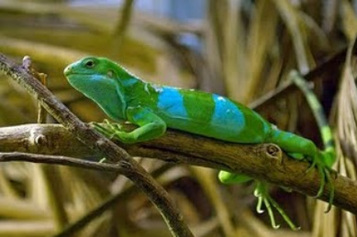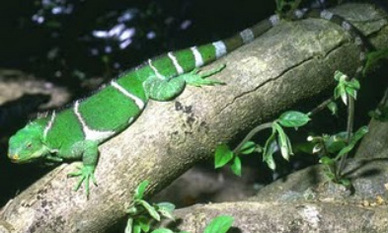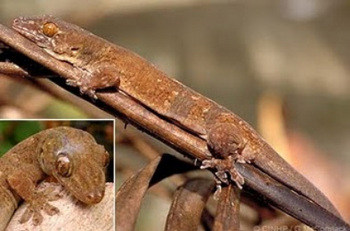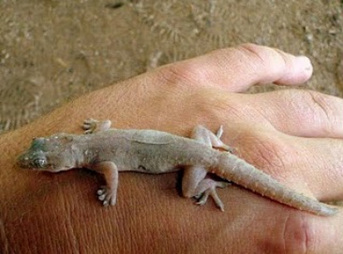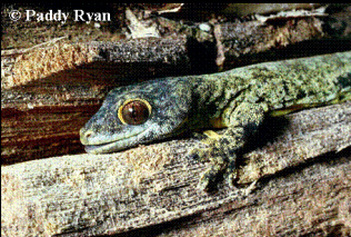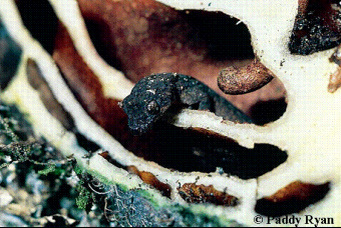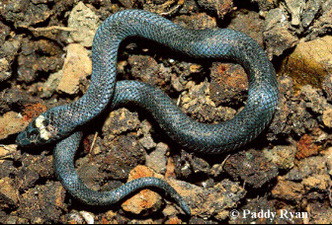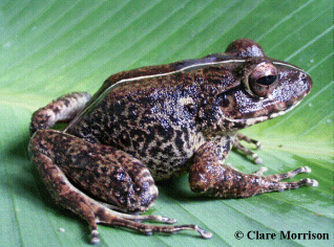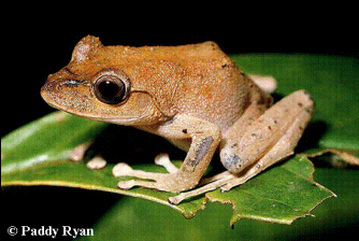HERPETOFAUNA
Fiji Banded Iguana [Brachylophus fasciatus]
Status: Endangered
Brachylophus fasciatus has bright-green to dark-green background color, white to bluish spots on neck and broad transverse white bands on side of its body; females are usually uniform green.Their eyes are reddish orange ans nasal scales are orange. They occur on the large Fijian islands, Viti Levu and Vanua Levu. The Fiji Banded Lizard is strongly arboreal and occurs in coastal and lowland forests. Diet appears to be mixed insectivory and herbivory. They appear to be diurnal, and sleep on low, horizontal branches in sheltered locations. Males appear to be territorial and aggressively defend their area from intruding males. Social encounters typically evoke profile changes in males as well as color changes. Courtship and mating begins in November and egg laying occurs in January to early March. The eggs require 125-210 days to hatch. Populations of these iguanas have been declining over the past century due to habitat destruction, and more significantly, the introduction of mongoose and house cats to the islands. It's status on IUCN is endangered. Fiji iguanas are considered a national treasure by the government of Fiji, and its likeness has been featured on postage stamps, currency, and phone book covers.
Brachylophus fasciatus has bright-green to dark-green background color, white to bluish spots on neck and broad transverse white bands on side of its body; females are usually uniform green.Their eyes are reddish orange ans nasal scales are orange. They occur on the large Fijian islands, Viti Levu and Vanua Levu. The Fiji Banded Lizard is strongly arboreal and occurs in coastal and lowland forests. Diet appears to be mixed insectivory and herbivory. They appear to be diurnal, and sleep on low, horizontal branches in sheltered locations. Males appear to be territorial and aggressively defend their area from intruding males. Social encounters typically evoke profile changes in males as well as color changes. Courtship and mating begins in November and egg laying occurs in January to early March. The eggs require 125-210 days to hatch. Populations of these iguanas have been declining over the past century due to habitat destruction, and more significantly, the introduction of mongoose and house cats to the islands. It's status on IUCN is endangered. Fiji iguanas are considered a national treasure by the government of Fiji, and its likeness has been featured on postage stamps, currency, and phone book covers.
Fiji Crested Iguana [Brachylophus vitiensis]
Status: Critically Endangered
Brachylophus have a green to nearly black background color; narrow, white, black-edged diagnol stripe on neck, and narrow, white, black-edged transverse bands on sides of body. These lizards are presently known from Yadua Tabu and the northern islands of the Yasawa group. They are strongly arboreal and lives in dry-beach-lowland forest. Crested iguanas appear to be entirely diurnal. Adults appear to be strictly herbivorous and, in captivity, eat large quantities of bananas, papayas, and flowers; hatchlings and juveniles eat insects as well as fruit and flowers. . Courtship and mating begin in January and extend through March. There appears to be 1 female in each male's territory, and females migrate en masse to nesting areas in April and May. Eggs require 32-36 weeks to hatch. The biggest threat this iguana faces is habitat loss due to fires, storms, agricultural development, and competition from feral goats. A secondary threat is introduced predators in the forms of rats, mongooses, and cats which prey on the iguanas and their eggs. Invasive Leucaena trees threaten the regeneration of native food trees for the iguanas, but the government of Fiji has taken steps to eradicate the treesAdditionally the iguana has been hunted as a food source and for the illegal animal trade.
Brachylophus have a green to nearly black background color; narrow, white, black-edged diagnol stripe on neck, and narrow, white, black-edged transverse bands on sides of body. These lizards are presently known from Yadua Tabu and the northern islands of the Yasawa group. They are strongly arboreal and lives in dry-beach-lowland forest. Crested iguanas appear to be entirely diurnal. Adults appear to be strictly herbivorous and, in captivity, eat large quantities of bananas, papayas, and flowers; hatchlings and juveniles eat insects as well as fruit and flowers. . Courtship and mating begin in January and extend through March. There appears to be 1 female in each male's territory, and females migrate en masse to nesting areas in April and May. Eggs require 32-36 weeks to hatch. The biggest threat this iguana faces is habitat loss due to fires, storms, agricultural development, and competition from feral goats. A secondary threat is introduced predators in the forms of rats, mongooses, and cats which prey on the iguanas and their eggs. Invasive Leucaena trees threaten the regeneration of native food trees for the iguanas, but the government of Fiji has taken steps to eradicate the treesAdditionally the iguana has been hunted as a food source and for the illegal animal trade.
Oceanic Gecko [Gehyra oceanica]
Status: N/A
Gehyra have a uniformly light olive to dark olive-brown on head and body; often orange spots or bands on posterior surface of hindlimbs. These geckos can occur as a human commensal and in forests. Its occurence on buildings tends to be associated with rural conditions where forests and gardens are nearby. They also occur regularly and abundantly in forests, from early successional to closed-canopied forests. Its diet appears to be exclusively insectivorous, including other arthropods as well, although other geckos may be a major dietary component. They are predominantly nocturnal in activity. The species shares communal nests of no more than twelve eggs in each, with only two eggs being laid by a female at a time. These eggs have a long incubation time of up to 115 days.
Gehyra have a uniformly light olive to dark olive-brown on head and body; often orange spots or bands on posterior surface of hindlimbs. These geckos can occur as a human commensal and in forests. Its occurence on buildings tends to be associated with rural conditions where forests and gardens are nearby. They also occur regularly and abundantly in forests, from early successional to closed-canopied forests. Its diet appears to be exclusively insectivorous, including other arthropods as well, although other geckos may be a major dietary component. They are predominantly nocturnal in activity. The species shares communal nests of no more than twelve eggs in each, with only two eggs being laid by a female at a time. These eggs have a long incubation time of up to 115 days.
Common House Gecko [Hemidactylus frenatus]
Status: Least Concern
Hemidactylus frenatus has a uniform beige to grayish beige color, or a series of olive-brown crossbar sand stripes on a beige background. Venter pale yellow or beige; underside of tail and vent area often pale orange, always orangish in hatchlings and juveniles. This species is a commensal of humans and has obtained a worldwide sub-tropical-tropical distribution, although of spotty occurrence outside of Asia. It's arrival and successful colonization in Fiji occured recently. The house gecko only occurs on buildings and other man-made structures in Fiji. It is nocturnal, emerging in full darkness.
Hemidactylus frenatus has a uniform beige to grayish beige color, or a series of olive-brown crossbar sand stripes on a beige background. Venter pale yellow or beige; underside of tail and vent area often pale orange, always orangish in hatchlings and juveniles. This species is a commensal of humans and has obtained a worldwide sub-tropical-tropical distribution, although of spotty occurrence outside of Asia. It's arrival and successful colonization in Fiji occured recently. The house gecko only occurs on buildings and other man-made structures in Fiji. It is nocturnal, emerging in full darkness.
Rotuman Forest Gecko [Lepidodactylus gardineri]
Status: N/A
Lepidodactylus gardineri is a gecko species found on the island of Rotuma. They live in secondary growth forest inside trees (i.e. Acalypha grandis, coconut palms, breadfruit trees). Their toes have distinct claws. If captured, they change color from brown (doral) and yellow (ventral) to mottled black, olive, or gray. Their tongues are black. Several individuals can be found in tree cavities left by termites. Any threat to Acalypha grandis also affects the Rotuman Forest Gecko since this particular tree is the preferred habitat.
Lepidodactylus gardineri is a gecko species found on the island of Rotuma. They live in secondary growth forest inside trees (i.e. Acalypha grandis, coconut palms, breadfruit trees). Their toes have distinct claws. If captured, they change color from brown (doral) and yellow (ventral) to mottled black, olive, or gray. Their tongues are black. Several individuals can be found in tree cavities left by termites. Any threat to Acalypha grandis also affects the Rotuman Forest Gecko since this particular tree is the preferred habitat.
Fiji Scaly-Toed Gecko [Lepidodactylus manni]
Status: N/A
Lepidodactylus manni is a gecko species found on the islands of Viti Levu, Ovalau, and Kadavu. They have oblong clawed pads on their feet. They are dark brown with various-colored markings. Their tongues are pinkish white. Favoring higher elevations, this species makes its home in the bark of dead trees, rock crevices, and in epiphytes. One of their greatest concerns is deforestation and forest fragmentation.
Lepidodactylus manni is a gecko species found on the islands of Viti Levu, Ovalau, and Kadavu. They have oblong clawed pads on their feet. They are dark brown with various-colored markings. Their tongues are pinkish white. Favoring higher elevations, this species makes its home in the bark of dead trees, rock crevices, and in epiphytes. One of their greatest concerns is deforestation and forest fragmentation.
Fiji Burrowing Snake [Ogmodon vitianus]
Status: Vulernable
Ogmodon vitianus is a snake species found on the island of Viti Levu. They average about 250mm in length. The head is small and the tail is short. Its scales are smooth and are brown or bluish. Unlike other snakes, it does not have a vertical pupil. Since it is a member of the cobra family, it is venomous. Specifically, it utilizes a neurotoxin, but the snake is non-aggressive. It is a nocturnal burrowing snake and eats worms, insects, and other arthropods. Its primary habitat in the Namosi Valley faces continual fragmentation.
Ogmodon vitianus is a snake species found on the island of Viti Levu. They average about 250mm in length. The head is small and the tail is short. Its scales are smooth and are brown or bluish. Unlike other snakes, it does not have a vertical pupil. Since it is a member of the cobra family, it is venomous. Specifically, it utilizes a neurotoxin, but the snake is non-aggressive. It is a nocturnal burrowing snake and eats worms, insects, and other arthropods. Its primary habitat in the Namosi Valley faces continual fragmentation.
Fiji Ground Frog [Platymantis vitianus]
Status: Endangered
Platymantis vitianus is a frog species found on the islands of Viti Levu, Vanua Levu, Taveuni, Koro, Gau, Kadavu, and Viwa. It is also a rainforest species, present all over the islands (including agricultural areas). The ground frog stays primarily on the ground (in logs, rock crevices, leaf litter), but is known to climb short bushes. It has small finger and toe discs. Often time, an “X” marking on the shoulders serves as a distinctive identifying feature. The frog is usually brown with whitish spots or stripes. The mongoose (predatory) and cane toads (competition) are a serious threat to the ground frog.
Platymantis vitianus is a frog species found on the islands of Viti Levu, Vanua Levu, Taveuni, Koro, Gau, Kadavu, and Viwa. It is also a rainforest species, present all over the islands (including agricultural areas). The ground frog stays primarily on the ground (in logs, rock crevices, leaf litter), but is known to climb short bushes. It has small finger and toe discs. Often time, an “X” marking on the shoulders serves as a distinctive identifying feature. The frog is usually brown with whitish spots or stripes. The mongoose (predatory) and cane toads (competition) are a serious threat to the ground frog.
Fiji Tree Frog [Platymantis vitiensis]
Status: Near Threatened
Platymantis vitiensis is a frog species found on the islands of Viti Levu, Vanua Levu, Taveuni, and Ovalau. Like its ground frog relative, it is also a rainforest species, present all over the islands (including agricultural areas). However, it is found higher in the canopy (i.e. in banana trees, Collospermum montanum) and in streamside vegetation (i.e. Tectaria latifolia). It can be found in a variety of colors including grays, browns, oranges, and yellows. Like the ground frog, it possesses distinct “X” or hourglass markings by the shoulders. They are highly acrobatic, as they can twist in mid-air after jumping, and can land and face in a different direction. This acts to confuses predators. Their main threat is deforestation, while the mongoose, rats, cats, and Pacific boa (Candoia bibroni) also present danger to populations dwelling closer to the ground.
Platymantis vitiensis is a frog species found on the islands of Viti Levu, Vanua Levu, Taveuni, and Ovalau. Like its ground frog relative, it is also a rainforest species, present all over the islands (including agricultural areas). However, it is found higher in the canopy (i.e. in banana trees, Collospermum montanum) and in streamside vegetation (i.e. Tectaria latifolia). It can be found in a variety of colors including grays, browns, oranges, and yellows. Like the ground frog, it possesses distinct “X” or hourglass markings by the shoulders. They are highly acrobatic, as they can twist in mid-air after jumping, and can land and face in a different direction. This acts to confuses predators. Their main threat is deforestation, while the mongoose, rats, cats, and Pacific boa (Candoia bibroni) also present danger to populations dwelling closer to the ground.
For more dry forest Herpetofauna, please visit the gallery
Back to the Top
Sources
Morrison, Clare. Key to the Herpetofauna of Fiji. University of the South Pacific, Suva. Retrived from <http://keys.lucidcentral.org/keys/phoenix/fiji/herpetofauna/Key%20to%20Fiji%27s%20Herpetofauna.html>
Zug, George R. The Lizards of Fiji: Natural History and Systematics. Bulletins in Zoology, Bishop Museum Press. Honolulu.1991
Hamilton, A. M., Hartman, J. H. and Austin, C. Island area and species diversity in the
southwest Pacific Ocean: is the lizard fauna of Vanuatu depauperate. Ecography. 32: 247–258. 2009.
Morrison, Clare and Alvereti Naikatini. Herpetofauna and bat monitoring at three Fiji sites in the Pacific-Asia Biodiversity Transect (PABITRA). Micronesica. 40(1/2): 131-137, 2008. Institute of Applied Sciences, University of the South Pacific.
Morrison, Clare. Key to the Herpetofauna of Fiji. University of the South Pacific, Suva. Retrived from <http://keys.lucidcentral.org/keys/phoenix/fiji/herpetofauna/Key%20to%20Fiji%27s%20Herpetofauna.html>
Zug, George R. The Lizards of Fiji: Natural History and Systematics. Bulletins in Zoology, Bishop Museum Press. Honolulu.1991
Hamilton, A. M., Hartman, J. H. and Austin, C. Island area and species diversity in the
southwest Pacific Ocean: is the lizard fauna of Vanuatu depauperate. Ecography. 32: 247–258. 2009.
Morrison, Clare and Alvereti Naikatini. Herpetofauna and bat monitoring at three Fiji sites in the Pacific-Asia Biodiversity Transect (PABITRA). Micronesica. 40(1/2): 131-137, 2008. Institute of Applied Sciences, University of the South Pacific.
